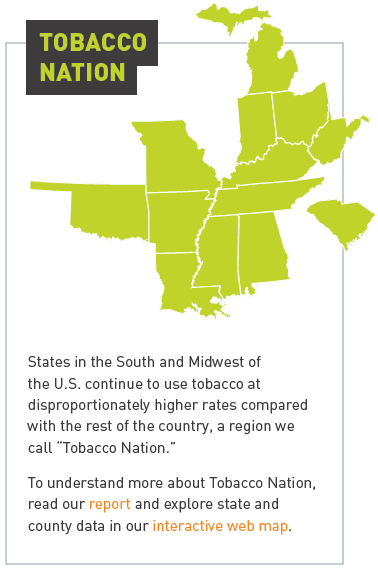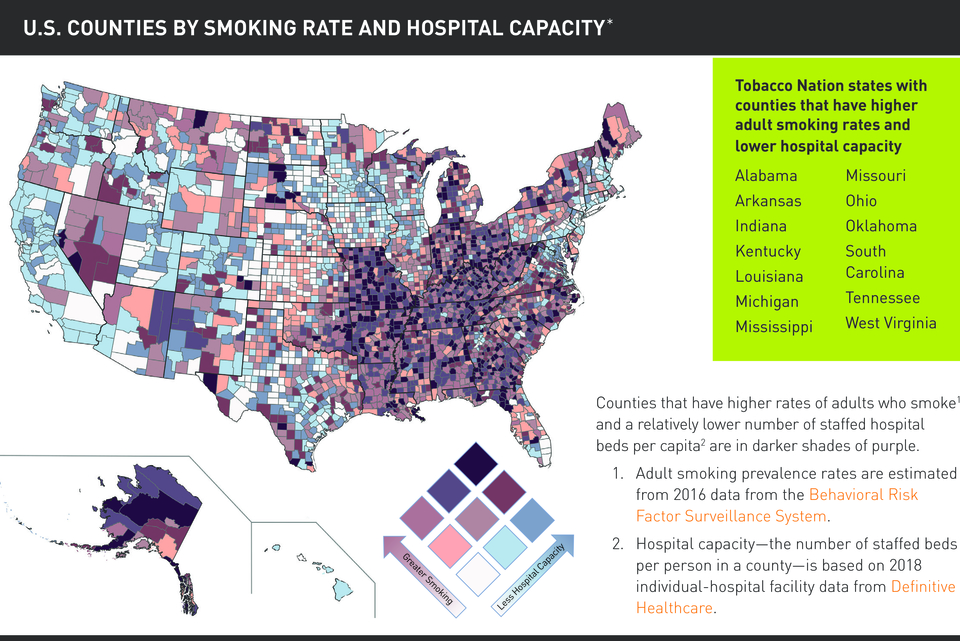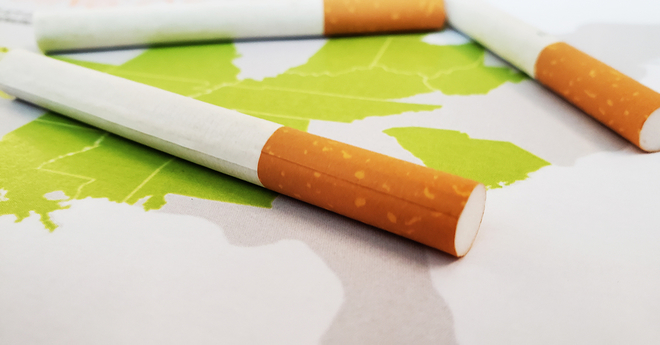
Tobacco Nation in the age of covid-19
High smoking rates and limited hospital bed capacity in rural communities create a dangerous situation and underscores health inequities
Areas of the country with high rates of smoking—a risk factor for COVID-19 infection and for developing severe outcomes—are also among those with the lowest hospital capacities, according to a Truth Initiative analysis.
The growing toll of the COVID-19 pandemic has hit vulnerable communities—particularly minority communities, those without health insurance and poorer access to health care, and those with underlying health conditions especially hard. While major urban cities have borne the brunt of this pandemic to date, rural communities face a unique set of challenges, including limited access to healthcare, that make them vulnerable to poorer health outcomes related to COVID-19.
This is of particular concern in Tobacco Nation—a collection of states with a large number of rural communities in the Midwest and South with an average adult smoking rate (21%) that exceeds the rest of the nation (15%).
Using both smoking data and recently available information on available hospital beds in all U.S. counties, researchers found that Tobacco Nation faces limited hospital bed capacities that could exacerbate the problems related to the COVID-19 epidemic.
Researchers determined that all 13 Tobacco Nation states had counties with limited hospital capacity: Alabama, Arkansas, Indiana, Kentucky, Louisiana, Michigan, Mississippi, Missouri, Ohio, Oklahoma, South Carolina, Tennessee, and West Virginia.
The rate of smoking compared to hospital capacity shows just one of the ways that communities who may be most vulnerable to the virus are also located in areas that are least equipped to handle an outbreak. The states in this region share not only greater tobacco use but fewer healthcare resources overall, higher poverty, and poorer health outcomes in general— making some of their residents particularly vulnerable if COVID-19 continues to spread in these communities.
SMOKERS ARE ESPECIALLY VULNERABLE TO COVID-19
Considering the health effects of smoking and vaping, U.S. agencies issued guidance and cautionary statements about the increased risk posed by COVID-19 to smokers:
- Those who smoke cigarettes may be at increased risk from COVID-19 infection and may have worse outcomes from COVID-19, the U.S. Food and Drug Administration said in its April 2020 statement.
- The U.S. Centers for Disease Control and Prevention includes smoking in a list of conditions that can compromise a person’s immune system and cause higher risk for severe illness from COVID-19.
- Smoking and many other tobacco products harm the heart and circulatory system, a concern when COVID-19 poses a higher risk to those with underlying heart problems.
Research on factors that make people more susceptible to COVID-19 and more likely to have worse outcomes is ongoing. Given that COVID-19 attacks the lungs, researchers are working to explore possible links between underlying factors—like tobacco use—and poorer virus outcomes. Although the research on the link between tobacco and e-cigarette use and COVID-19 is evolving, the negative effects of smoking and vaping on lung and heart health are clear.
Although the research on the link between tobacco and e-cigarette use and COVID-19 is evolving, the negative effects of smoking and vaping on lung and heart health are clear.
WHERE YOU LIVE MATTERS
Areas with more smokers and fewer places to treat those who fall ill may fare worse than those areas with better infrastructure in place and less demand.
Truth Initiative researchers sought to better understand the implications of this relationship by mapping out the number of staffed hospital beds and adult smoking rates in each county. The resulting map illustrates one aspect of preparedness of healthcare systems around the country to handle an influx of COVID-19 patients in the event of resurgence or further spread of the virus.
They found that some of the most prominent areas with the highest smoking rates and lowest hospital capacities are in Tobacco Nation and other counties in the Midwestern and Southern U.S. states.
Many of the counties identified in the map as having high smoking rates and low hospital capacity are in Tobacco Nation, including all 13 Tobacco Nation states, mentioned below. These states, along with other states outside of Tobacco Nation like Alaska, Georgia, Florida, North Carolina, South Dakota, North Dakota, Montana, Nevada, Texas, Virginia, New York, and Maine, include counties with some of the most alarming overlap of higher adult smoking rates and lower hospital capacity.
COVID-19’S MARCH TOWARD RURAL COMMUNITIES
While most cases of COVID-19 have been located in cities and their surrounding communities, many public health professionals worry that it will continue to spread in the upcoming months, including a further expansion to rural communities—a concern since hospital beds are already limited in these areas.
Healthcare infrastructure in many rural communities in places like Tobacco Nation is often limited in facilities, staff, and funding and hospitals in rural areas continue to shut down even during the pandemic—12 small-town hospitals closed in 2020 alone. The lack of healthcare resources is particularly concerning since many rural communities have higher rates of tobacco use.
The challenges facing Tobacco Nation and other communities with at-risk populations are further complicated by the enormous strain COVID-19 is placing on healthcare systems. States and communities are providing crucial medical care but many hospitals and other providers have been stretched to the limits of their capacity. There are also concerns that hospitals without enough intensive care unit beds may still be unprepared for a resurgence in cases, particularly as early summer has seen an increase in cases in some areas of the country. Understanding where vulnerable populations and higher risk communities are located can help states, cities, and hospitals continue to prepare themselves as COVID-19 remains a reality for the forseeable future in the U.S.
THERE’S NEVER BEEN A BETTER TIME TO QUIT
There has never been a more important time for people to quit using tobacco—no matter the product— to protect their health. Truth Initiative offers several quitting programs that can quadruple a tobacco user’s chance of quitting:
- BecomeAnEX is a digital quit-smoking plan and online community of thousands of smokers and ex-smokers that has helped more than 800,000 people develop the skills and confidence to successfully quit. The comprehensive program, which also helps users quit vaping, chewing or dipping, helps people quit with tailored resources and the most up-to-date guidance on quitting from our partners at Mayo Clinic.
- The EX Program—founded on BecomeAnEX—is Truth Initiative’s enterprise quit program for employers and health plans to help their employees, members and their families.
- This is Quitting, an anonymous text message program designed to help teens and young adults quit vaping, offers tips, encouragement and a sense of community, and includes information about building skills to help manage stress and reduce anxiety related to quitting.
STRONG HEALTHCARE AND TOBACCO POLICIES ARE CRITICAL
COVID-19 has brought to the forefront glaring inequalities in health care and tobacco use rates that were always present. While this report focuses on communities with high tobacco use, it is clear that communities of color have been disproportionately affected by COVID-19. Public health efforts to address ongoing inequalities must take these communities into account. The pandemic and related public health challenges underscores the critical need for strong tobacco control policies, including:
- Don’t delay federal review of tobacco products. The global pandemic should not be an excuse to derail existing progress. Due to the COVID-19 crisis, the Food and Drug Administration already granted a 120-day extension of the deadline for e-cigarette manufacturers to submit their products for FDA review and this essential process must not be further delayed.
- Implement strong tobacco policies. Federal, state, and local governments must do more to protect their residents from the harms of tobacco. Raising taxes on tobacco and thereby increasing its price is one of the most effective ways to reduce tobacco use—research shows that increases in tobacco taxes decrease tobacco use. From raising the price of tobacco products by increasing tobacco taxes, smoke-free policies, flavor restrictions, litter fees, banning sale of tobacco products in pharmacies and near schools, and keeping tobacco products out of view in stores, most residents of Tobacco Nation support many of these evidence-based policies, according to a Truth Initiative survey.
Facing an unprecedented public health challenge requires us all to take every step to mitigate the risks and consequences of COVID-19, including encouraging tobacco cessation and supporting policies to make it harder to start and easier to quit. Together we can work to limit the disparities that threaten the most vulnerable Americans.





